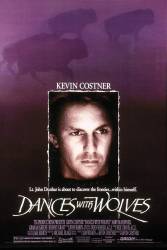Visible crew/equipment: In the scene where the Sioux discover the rotting dead buffalo lying in the valley, as they are riding by them, right after they show a Sioux woman crying, in the background you can see a man with dark hair in a white shirt lying on the ground. In the special edition DVD, if you watch this scene with the commentary on you will hear Kevin Costner and Jim Wilson admit that it is an assistant cameraman trying to get out of the scene. (01:49:55)

Dances with Wolves (1990)
1 visible crew/equipment mistake
Directed by: Kevin Costner
Starring: Kevin Costner, Mary McDonnell, Graham Greene, Rodney A. Grant
Continuity mistake: The piece of meat that Dunbar offers the wolf changes shape and size dramatically throughout that scene.
Lt. Elgin: Spivy! You bash that prisoner one more time, I'll put those shackles on you.
Trivia: For his portrait of the Indians (which was radically different from all the earlier movies), Costner was made an honorary tribe member of the real-life Sioux.
Question: Why did Dunbar's superior kill himself as Dunbar was being taken to his new post?
Answer: Dunbar's superior supported the British ("The King is dead... Long live the King" said with a heavy British accent) and was likely a closet-case Redcoat his entire US military career. It was not rare and many suicides were a result of that.
This claim is not supported by the movie. "The King is dead. Long live the King" is a common idiom referring to the passing of power to someone new. It most definitely does not literally refer to the English King. The movie is set in the middle of Queen Victoria's reign. As for your assertion that there were a large number of English loyalists in the Union Army three generations after the Revolutionary War seems highly unlikely. Can you cite evidence of this?





Answer: He was mentally disturbed and was depressed about being assigned to a "dead end" post with no chance at advancement. Dunbar, the hero, choosing to be assigned to the frontier, just pushed the poor soul over the edge.
Mark English
In a word, the disease syphilis. The urinary tract problems and the Insanity are possible side effects.
What are you basing this on? What in the movie indicates that he has syphilis?